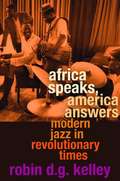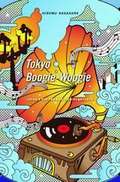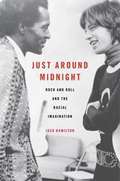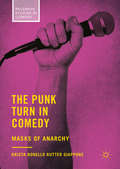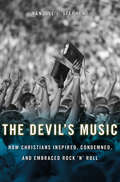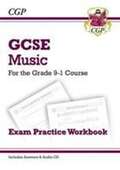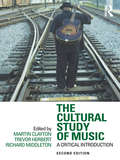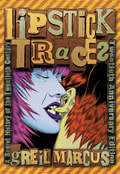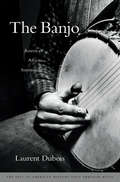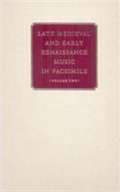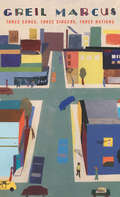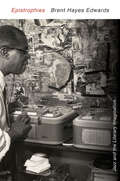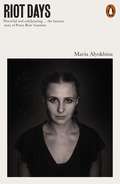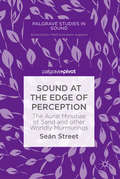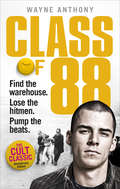- Table View
- List View
Africa Speaks, America Answers: Modern Jazz in Revolutionary Times (The Nathan I. Huggins lectures #13)
by Robin D. KelleyThis collective biography of four jazz musicians from Brooklyn, Ghana, and South Africa demonstrates how modern Africa reshaped jazz, how modern jazz helped form a new African identity, and how musical convergences and crossings altered the politics and culture of both continents.
Tokyo Boogie-Woogie: Japan’s Pop Era and Its Discontents
by Hiromu NagaharaEmerging in the 1920s, the Japanese pop scene gained a devoted following, and the soundscape of the next four decades became the audible symbol of changing times. In the first English-language history of this Japanese industry, Hiromu Nagahara connects the rise of mass entertainment with Japan’s transformation into a postwar middle-class society.
The Devil’s Music: How Christians Inspired, Condemned, and Embraced Rock ’n’ Roll
by Randall J. StephensWhen rock ’n’ roll emerged in the 1950s, ministers denounced it from their pulpits and Sunday school teachers warned of the music’s demonic origins. The big beat, said Billy Graham, was “ever working in the world for evil.” Yet by the early 2000s Christian rock had become a billion-dollar industry. The Devil’s Music tells the story of this transformation. Rock’s origins lie in part with the energetic Southern Pentecostal churches where Elvis, Little Richard, James Brown, and other pioneers of the genre worshipped as children. Randall J. Stephens shows that the music, styles, and ideas of tongue-speaking churches powerfully influenced these early performers. As rock ’n’ roll’s popularity grew, white preachers tried to distance their flock from this “blasphemous jungle music,” with little success. By the 1960s, Christian leaders feared the Beatles really were more popular than Jesus, as John Lennon claimed. Stephens argues that in the early days of rock ’n’ roll, faith served as a vehicle for whites’ racial fears. A decade later, evangelical Christians were at odds with the counterculture and the antiwar movement. By associating the music of blacks and hippies with godlessness, believers used their faith to justify racism and conservative politics. But in a reversal of strategy in the early 1970s, the same evangelicals embraced Christian rock as a way to express Jesus’s message within their own religious community and project it into a secular world. In Stephens’s compelling narrative, the result was a powerful fusion of conservatism and popular culture whose effects are still felt today.
Just around Midnight: Rock And Roll And The Racial Imagination
by Jack HamiltonWhen Jimi Hendrix died, the idea of a black man playing lead guitar in a rock band seemed exotic. Yet ten years earlier, Chuck Berry had stood among the most influential rock and roll performers. Why did rock and roll become white? Jack Hamilton challenges the racial categories that distort standard histories of rock music and the 60s revolution.
The Punk Turn in Comedy
by Krista Bonello Rutter GiapponeThis book examines the interconnections between punk and alternative comedy (altcom). It explores how punk’s tendency towards humour and parody influenced the trajectory taken by altcom in the UK, and the punk strategies introduced when altcom sought self-definition against dominant established trends. The Punk Turn in Comedy considers the early promise of punk-comedy convergence in Peter Cook and Dudley Moore’s ‘Derek and Clive’, and discusses punk and altcom’s attitudes towards dominant traditions. The chapters demonstrate how punk and altcom sought a direct approach for critique, one that rejected innuendo, while embracing the ‘amateur’ in style and experimenting with audience-performer interaction. Giappone argues that altcom tended to be more consistently politicised than punk, with a renewed emphasis on responsibility. The book is a timely exploration of the ‘punk turn’ in comedy history, and will speak to scholars of both comedy and punk studies.
Three Songs, Three Singers, Three Nations (The William E. Massey Sr. lectures in the history of American civilization ; #2013)
by Greil MarcusGreil Marcus delves into three distinct episodes in the history of American commonplace song and shows how each one manages to convey the uncanny sense that it was written by no one. In these seemingly anonymous productions, we discover three different ways of talking about the United States, and three separate nations within its borders.
Freedom and the Arts: Essays on Music and Literature
by Charles RosenIs there a moment in history when a work receives its ideal interpretation? Or is perpetual negotiation required to preserve the past and accommodate the present? The freedom of interpretation, Charles Rosen suggests in these sparkling explorations, exists in a delicate balance with fidelity to the identity of the original work.
Just around Midnight: Rock And Roll And The Racial Imagination
by Jack HamiltonWhen Jimi Hendrix died, the idea of a black man playing lead guitar in a rock band seemed exotic. Yet ten years earlier, Chuck Berry had stood among the most influential rock and roll performers. Why did rock and roll become white? Jack Hamilton challenges the racial categories that distort standard histories of rock music and the 60s revolution.
Music as Biology: The Tones We Like And Why
by Dale PurvesWhy do human beings find some tone combinations consonant and others dissonant? Why do we make music using only a small number of scales out the billions that are possible? Dale Purves shows that rethinking music theory in biological terms offers a new approach to centuries-long debates about the organization and impact of music.
Orpheus in the Marketplace: Jacpoo Peri and the Economy of Late Renaissance Florence (I Tatti studies in Italian Renaissance history #10)
by Tim CarterThe Florentine musician Jacopo Peri (1561-1633) is known as the composer of the first operas--they include the earliest to survive complete, Euridice (1600), in which Peri sang the role of Orpheus. The recent discovery of a large number of private account books belonging to him and his family allows for a greater exploration of Peri's professional and personal life. Richard Goldthwaite, an economic historian, and Tim Carter, a musicologist, have done more, however, than write a biography: their investigation exposes the value of such financial documents as a primary source for an entire period. This record of Peri's wide-ranging investments and activities in the marketplace enables the first detailed account of the Florentine economy in the late sixteenth and early seventeenth centuries, and opens a new perspective on one of Europe's principal centers of capitalism. His economic circumstances reflect continuities and transformations in Florentine society, and the strategies for negotiating them, under the Medici grand dukes. They also allow a reevaluation of Peri the singer and composer that elucidates the cultural life of a major artistic center even in changing times, providing a quite different view of what it meant to be a musician in late Renaissance Italy.
Tokyo Boogie-Woogie: Japan’s Pop Era and Its Discontents
by Hiromu NagaharaEmerging in the 1920s, the Japanese pop scene gained a devoted following, and the soundscape of the next four decades became the audible symbol of changing times. In the first English-language history of this Japanese industry, Hiromu Nagahara connects the rise of mass entertainment with Japan’s transformation into a postwar middle-class society.
The Devil’s Music: How Christians Inspired, Condemned, and Embraced Rock ’n’ Roll
by Randall J. StephensWhen rock ’n’ roll emerged in the 1950s, ministers denounced it from their pulpits and Sunday school teachers warned of the music’s demonic origins. The big beat, said Billy Graham, was “ever working in the world for evil.” Yet by the early 2000s Christian rock had become a billion-dollar industry. The Devil’s Music tells the story of this transformation. Rock’s origins lie in part with the energetic Southern Pentecostal churches where Elvis, Little Richard, James Brown, and other pioneers of the genre worshipped as children. Randall J. Stephens shows that the music, styles, and ideas of tongue-speaking churches powerfully influenced these early performers. As rock ’n’ roll’s popularity grew, white preachers tried to distance their flock from this “blasphemous jungle music,” with little success. By the 1960s, Christian leaders feared the Beatles really were more popular than Jesus, as John Lennon claimed. Stephens argues that in the early days of rock ’n’ roll, faith served as a vehicle for whites’ racial fears. A decade later, evangelical Christians were at odds with the counterculture and the antiwar movement. By associating the music of blacks and hippies with godlessness, believers used their faith to justify racism and conservative politics. But in a reversal of strategy in the early 1970s, the same evangelicals embraced Christian rock as a way to express Jesus’s message within their own religious community and project it into a secular world. In Stephens’s compelling narrative, the result was a powerful fusion of conservatism and popular culture whose effects are still felt today.
New GCSE Music Exam Practice Workbook - for the Grade 9-1 Course (with Audio CD & Answers) (PDF)
by Cgp Books"This Exam Practice Workbook from CGP is a fantastic way to prepare for the Grade 9-1 GCSE Music exams. It contains exam-style questions covering a huge range of musical styles (with listening practice on CD), plus plenty of advice for scoring top marks in the real exams. Complete answers to every question are included. For more help with Grade 9-1 GCSE Music, matching CGP Complete Revision & Practice guides are available for the AQA (9781782946144), Edexcel (9781782946151) and OCR (9781782946168) exam boards. "
The Cultural Study of Music: A Critical Introduction
by Trevor Herbert Richard Middleton Martin ClaytonWhat is the relationship between music and culture? The first edition of The Cultural Study of Music: A Critical Introduction explored this question with groundbreaking rigor and breadth. Now this second edition refines that original analysis while examining the ways the field has developed in the years since the book’s initial publication. Including contributions from scholars of music, cultural studies, anthropology, sociology, and psychology, this anthology provides a comprehensive introduction to the study of music and culture. It includes both pioneering theoretical essays and exhaustively researched case studies on particular issues in world musics. For the second edition, the original essays have been revised and nine new chapters have been added, covering themes such as race, religion, geography, technology, and the politics of music. With an even broader scope and a larger roster of world-renowned contributors, The Cultural Study of Music is certain to remain a canonical text in the field of cultural musicology.
The Cultural Study of Music: A Critical Introduction
by Trevor Herbert Richard Middleton Martin ClaytonWhat is the relationship between music and culture? The first edition of The Cultural Study of Music: A Critical Introduction explored this question with groundbreaking rigor and breadth. Now this second edition refines that original analysis while examining the ways the field has developed in the years since the book’s initial publication. Including contributions from scholars of music, cultural studies, anthropology, sociology, and psychology, this anthology provides a comprehensive introduction to the study of music and culture. It includes both pioneering theoretical essays and exhaustively researched case studies on particular issues in world musics. For the second edition, the original essays have been revised and nine new chapters have been added, covering themes such as race, religion, geography, technology, and the politics of music. With an even broader scope and a larger roster of world-renowned contributors, The Cultural Study of Music is certain to remain a canonical text in the field of cultural musicology.
Lipstick Traces: A Secret History Of The Twentieth Century
by Greil MarcusThis is a secret history of modern times, told by way of what conventional history tries to exclude. Lipstick Traces tells a story as disruptive and compelling as the century itself.
Lipstick Traces: A Secret History Of The Twentieth Century
by Greil MarcusThis is a secret history of modern times, told by way of what conventional history tries to exclude. Lipstick Traces tells a story as disruptive and compelling as the century itself.
The Banjo: America's African Instrument
by Laurent DuboisAmerican slaves drew on memories of African musical traditions to construct instruments from carved-out gourds covered with animal skin. Providing a sense of rootedness, solidarity, and consolation, banjo picking became an essential part of black plantation life, and its unmistakable sound remains versatile and enduring today, Laurent Dubois shows.
The Lucca Choirbook: Lucca, Archivio Di Stato, Ms 238 - Lucca, Archivio Arcivescovile, Ms 97 - Pisa, Archivio Arcivescovile, Biblioteca Maffi, Cartella 11/iii (PDF) (Late Medieval And Early Renaissance Music In Facsimile Ser. #2)
by Reinhard StrohmMore than forty years ago in the state archives of Lucca, Italy, musicologist Reinhard Strohm noticed that bindings on some of the books were unusual: they consisted of the pages of a centuries-old music manuscript. In the following years, Strohm worked with the archivists to remove these leaves and reassemble as much as possible of the original manuscript, a major cultural recovery now known as The Lucca Choirbook. The recovered volume comprises what remains of a gigantic cathedral codex commissioned in Bruges around 1463 and containing English, Franco-Flemish, and Italian sacred music of the fifteenth century—including works by the celebrated composers Guillaume Du Fay and Henricus Isaac. This facsimile of the choirbook includes all the known leaves, ordered according to their proper placement in the original codex. In the introduction, Strohm tells the fascinating story of this choirbook, identifying its early users and reconstructing its travel from Bruges to Lucca.
Three Songs, Three Singers, Three Nations (The William E. Massey Sr. lectures in the history of American civilization ; #2013)
by Greil MarcusGreil Marcus delves into three distinct episodes in the history of American commonplace song and shows how each one manages to convey the uncanny sense that it was written by no one. In these seemingly anonymous productions, we discover three different ways of talking about the United States, and three separate nations within its borders.
Epistrophies: Jazz And The Literary Imagination
by Brent Hayes EdwardsHearing across media is the source of innovation in a uniquely African American sphere of art-making and performance, Brent Hayes Edwards writes. He explores this fertile interface through case studies in jazz literature both writings informed by music and the surprisingly large body of writing by jazz musicians themselves.
Riot Days
by Maria AlyokhinaFrom activist, Pussy Riot member and freedom fighter Maria Alyokhina, a raw, hallucinatory, passionate account of her arrest, trial and imprisonment in a penal colony in the Urals for standing up for what she believed in.'One of the most brilliant and inspiring things I've read in years. Couldn't put it down. This book is freedom' Chris Kraus, author of I Love Dick'Reading: RIOT DAYS, by PussyRiot member MariaAlyokhina. A women's prison memoir like no other! One tough cookie!' @MargaretAtwood'In oppressive political systems, some of the most effective weapons are sarcasm and dark humour. It is exactly these weapons that are employed by Masha Alyokhina in the brilliantly written Riot Days. Once you begin reading, you are completely disarmed, unable to put it down until the last page' Marina AbramovicPeople who believe in freedom and democracy think it will exist forever.That is a mistake. What happened in Russia - what happened to me - could happen anywhere.When I was jailed for political protest, I learned that prison doesn't just teach you to follow the rules. It teaches you to think that you can never break them.It's inevitable that the prison gates will open at some point. But this doesn't mean that you leave the 'prisoner' category and go straight into the category of 'the free'.Freedom does not exist unless you fight for it every day.This is the story about how I made a choice.We are all Pussy Riot.And actions break fear. 'To Back Down an Inch is to Give Up a Mile'.
Sound at the Edge of Perception: The Aural Minutiae of Sand and other Worldly Murmurings (Palgrave Studies in Sound)
by Seán StreetThis book is about the tiny sounds of the world, and listening to them, the minute signals that are clues to who and where we are. A very small sound, given the context of its history, becomes hugely significant, and even an imagined sound in a picture becomes almost a voice. By speaking a name, we give a person back to the world, and a breath, a sigh, a laugh or a cry need no language. A phoneme is the start of all stories, and were we able to tune ourselves to the subtleties of the natural world, we might share the super-sensitivity of members of the bird and animal kingdom to sense the message in the apparent silence. Mind hears sound when it perceives an image; the book will appeal to sonic and radio practitioners, students of sound, those working in the visual arts, and creative writers.
Sound at the Edge of Perception: The Aural Minutiae of Sand and other Worldly Murmurings (Palgrave Studies in Sound)
by Seán StreetThis book is about the tiny sounds of the world, and listening to them, the minute signals that are clues to who and where we are. A very small sound, given the context of its history, becomes hugely significant, and even an imagined sound in a picture becomes almost a voice. By speaking a name, we give a person back to the world, and a breath, a sigh, a laugh or a cry need no language. A phoneme is the start of all stories, and were we able to tune ourselves to the subtleties of the natural world, we might share the super-sensitivity of members of the bird and animal kingdom to sense the message in the apparent silence. Mind hears sound when it perceives an image; the book will appeal to sonic and radio practitioners, students of sound, those working in the visual arts, and creative writers.
Class of '88: Find the warehouse. Lose the hitmen. Pump the beats.
by Wayne AnthonyOrganised crime puts on a smiley face.When the Summer of Love hit Britain in ’88, Wayne embraced the bright new world of dance music, MDMA and all-night celebrations. But alongside the ecstasy, his natural East End entrepreneurial instincts kicked in, and he began to organise the infamous Genesis dance parties for thousands of kids. Wayne soon became a key figure in the high octane, technicolour rave scene. But beneath the shiny, smiley surfaces, he quickly found himself in a vicious world of violence, police harassment and organised crime, for which he was totally unsuited and unprepared. He was beaten by ex-paratroopers, menaced by gangsters, kidnapped, confronted with sawn off shotguns and threatened with murder, all so Britain could party like never before.When Class of ’88 was first published, it was so popular that Foyles dedicated an entire window to the book for a month. Now, re-issued for the 30th anniversary, this is Wayne’s very lively, highly individual account of the two years he spent as an illegal party promoter, leading the rave revolution which was sweeping the UK, changing lives, music and popular culture forever.
